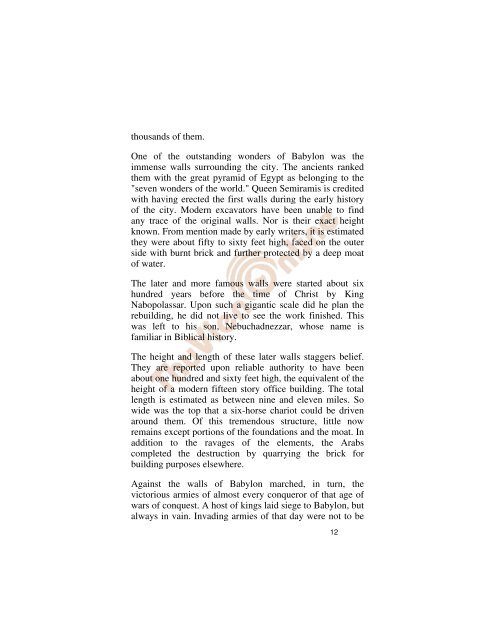The Richest Man In Babylon - InvestInRealEstate101
The Richest Man In Babylon - InvestInRealEstate101
The Richest Man In Babylon - InvestInRealEstate101
You also want an ePaper? Increase the reach of your titles
YUMPU automatically turns print PDFs into web optimized ePapers that Google loves.
thousands of them.<br />
One of the outstanding wonders of <strong>Babylon</strong> was the<br />
immense walls surrounding the city. <strong>The</strong> ancients ranked<br />
them with the great pyramid of Egypt as belonging to the<br />
"seven wonders of the world." Queen Semiramis is credited<br />
with having erected the first walls during the early history<br />
of the city. Modern excavators have been unable to find<br />
any trace of the original walls. Nor is their exact height<br />
known. From mention made by early writers, it is estimated<br />
they were about fifty to sixty feet high, faced on the outer<br />
side with burnt brick and further protected by a deep moat<br />
of water.<br />
<strong>The</strong> later and more famous walls were started about six<br />
hundred years before the time of Christ by King<br />
Nabopolassar. Upon such a gigantic scale did he plan the<br />
rebuilding, he did not live to see the work finished. This<br />
was left to his son, Nebuchadnezzar, whose name is<br />
familiar in Biblical history.<br />
<strong>The</strong> height and length of these later walls staggers belief.<br />
<strong>The</strong>y are reported upon reliable authority to have been<br />
about one hundred and sixty feet high, the equivalent of the<br />
height of a modern fifteen story office building. <strong>The</strong> total<br />
length is estimated as between nine and eleven miles. So<br />
wide was the top that a six-horse chariot could be driven<br />
around them. Of this tremendous structure, little now<br />
remains except portions of the foundations and the moat. <strong>In</strong><br />
addition to the ravages of the elements, the Arabs<br />
completed the destruction by quarrying the brick for<br />
building purposes elsewhere.<br />
Against the walls of <strong>Babylon</strong> marched, in turn, the<br />
victorious armies of almost every conqueror of that age of<br />
wars of conquest. A host of kings laid siege to <strong>Babylon</strong>, but<br />
always in vain. <strong>In</strong>vading armies of that day were not to be<br />
12
















